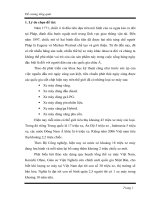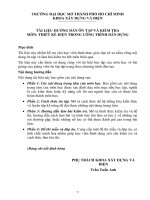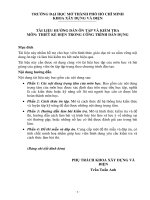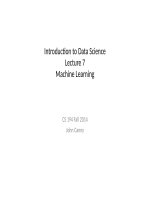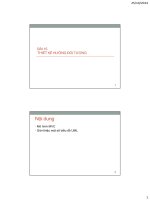ORF363 COS323 F14 Lec15
Bạn đang xem bản rút gọn của tài liệu. Xem và tải ngay bản đầy đủ của tài liệu tại đây (4.32 MB, 58 trang )
<span class='text_page_counter'>(1)</span><div class='page_container' data-page=1>
Discrete Optimization
(at IBM's Mathematical Sciences Department)
Sanjeeb Dash
IBM Research
Lecture, ORF 363
</div>
<span class='text_page_counter'>(2)</span><div class='page_container' data-page=2>
Outline
. Optimization at IBM
. Discrete Optimization basics
- Problems
- Relaxations
- Modeling
. Solution techniques: integer programming
. Applications
</div>
<span class='text_page_counter'>(3)</span><div class='page_container' data-page=3>
IBM Research
IBM: 431,212 employees
</div>
<span class='text_page_counter'>(4)</span><div class='page_container' data-page=4>
IBM's Math. Sciences Dept.
IBM Mathematical Sciences Department:
50+ years old
50+ people
50 % funding from contracts, 50% from IBM grants
</div>
<span class='text_page_counter'>(5)</span><div class='page_container' data-page=5>
Discrete Optimization
</div>
<span class='text_page_counter'>(6)</span><div class='page_container' data-page=6>
Application areas
Airlines route planning, crew scheduling American, United
revenue management Air New Zealand, British Airways
Package Delivery vehicle routing UPS, Fedex, USPS
Trucking route planning, vehicle routing Schnieder
Transportation network optimization Amazon
Telecommunication network design AT&T
Shipping route planning Maersk
Pipelines batch scheduling CLC
Steel Industry cutting stock Posco
Paper Industry cutting stock GSE mbH
Finance portfolio management Axioma
Oil & Gas ExxonMobil
Petrochemicals SK Innovation
Power generation unit commitment, resource management BC Hydro
</div>
<span class='text_page_counter'>(7)</span><div class='page_container' data-page=7>
Recent jobs in optimization
American Airlines - Analyst Revenue Management Operations Research
Mathematical programming (M.S./Ph.D.)
Amazon - Operations Research Scientist
Network optimization, linear, mixed-integer programming (Ph.D.)
SK Innovation - Researcher - Optimization and Analytics
Nonlinear/mixed-integer programming, global optimization, stochastic programming (Ph.D.)
BC Hydro - Hydroelectric Optimization Specialist
Stochastic optimization (M.S.)
E. J. Gallo Winery - Analyst 2 - Operations Research Numerical optimization (linear and
integer), Tools such as CPLEX,OPL (B.S.)
Monsanto - Senior Operations Research
</div>
<span class='text_page_counter'>(8)</span><div class='page_container' data-page=8>
ExxonMobil -Optimization Modeling
Nonlinear and mixed-integer nonlinear optimization (Ph.D.)
CSX - Optimization
Mixed integer programming, heuristics and meta-heuristics, network algorothms (Ph.D.)
Nestle - Supply Chain Business Analyst / Operations Research Analyst
Optimization (linear programming and mixed-integer programming) (B.S.)
</div>
<span class='text_page_counter'>(9)</span><div class='page_container' data-page=9>
Knapsack Problem
</div>
<span class='text_page_counter'>(10)</span><div class='page_container' data-page=10>
Knapsack Problem
<b>unbounded knapsack</b>
<b>Items</b>
<b>Knapsack</b>
<b>....</b>
<b>0−1 knapsack solutions</b>
</div>
<span class='text_page_counter'>(11)</span><div class='page_container' data-page=11>
Cutting stock
Pack items into as few identical knapsacks as possible
<b>Solution:</b>
<b>2 x</b> <b>3 x</b>
<b>....</b>
<b>Stock:</b>
<b>2 x</b>
</div>
<span class='text_page_counter'>(12)</span><div class='page_container' data-page=12>
Traveling Salesman Problem
TSP: Minimize distance traveled while visiting a collection of cities and
returning to the starting point.
</div>
<span class='text_page_counter'>(13)</span><div class='page_container' data-page=13></div>
<span class='text_page_counter'>(14)</span><div class='page_container' data-page=14>
10-city instance
0 - Chicago 1 - Erie
2 - Chattanooga
3 - Kansas City
4 - Lincoln
5 - Wichita
6 - Amarillo
9 - Reno
8 - Boise
7 - Butte
</div>
<span class='text_page_counter'>(15)</span><div class='page_container' data-page=15>
10-city instance
0 1 2 3 4 5 6 7 8 9
0 Chicago 0
1 Erie 449 0
2 Chattanooga 618 787 0
3 Kansas City 504 937 722 0
4 Lincoln 529 1004 950 219 0
5 Wichita 805 1132 842 195 256 0
6 Amarillo 1181 1441 1080 563 624 368 0
7 Butte 1538 2045 2078 1378 1229 1382 1319 0
8 Boise 1716 2165 2217 1422 1244 1375 1262 483 0
</div>
<span class='text_page_counter'>(16)</span><div class='page_container' data-page=16>
Some solutions
Tours of length 6633 and 6514 miles
0 <sub>1</sub>
2
3
4
5
6
9
8
7
0 <sub>1</sub>
2
3
4
5
6
9
8
7
</div>
<span class='text_page_counter'>(17)</span><div class='page_container' data-page=17>
Vehicle Routing
<b>[10,90]</b>
</div>
<span class='text_page_counter'>(18)</span><div class='page_container' data-page=18>
Min-max vehicle routing
120
1
</div>
<span class='text_page_counter'>(19)</span><div class='page_container' data-page=19>
1996 Whizzkids challenge
. 5000 Dutch Guilders prize sponsored by CMG
. Winners: Hemel, van Erk, Jenniskens (U. Eindhoven students)
. Max path length of 1183. Local search techniques, 15,000 hours of
computing time.
</div>
<span class='text_page_counter'>(20)</span><div class='page_container' data-page=20>
Path 1: 1178
Path 2: 1183
Path 3: 1173
Path 4: 1183
</div>
<span class='text_page_counter'>(21)</span><div class='page_container' data-page=21>
Integer programming
min 5x + 8y subject to
:9x + y 1:5; x + 3:1y 2:4
0 x 3:5; 0 y 3:3; x; y integral
<b> y = 3.3</b>
<b> c=(−5,−8)</b> <b> 5x + 8y = 8</b>
<b> 5x + 8y = 21</b>
<b> 5x + 8y = 34</b>
<b> 5x + 8y = 47</b>
<b> .9x + y = 1.5</b>
<b> x + 3.1y = 2.4</b>
<b> x = 3.5</b>
</div>
<span class='text_page_counter'>(22)</span><div class='page_container' data-page=22>
NP-completeness
</div>
<span class='text_page_counter'>(23)</span><div class='page_container' data-page=23>
Diculty of optimization problems
. Sort n numbers: At most n2 <sub>comparisons between pairs of numbers.</sub>
. Spanning tree problem: O(n2 <sub>log n) operations (i.e., at most Cn</sub>2 <sub>log n for</sub>
some constant C).
- Polynomial-time algorithms by Boruvka '26, Prim '57, Kruskal '56.
. Traveling salesman problem: O(n2<sub>2</sub>n<sub>) algorithm by Held and Karp</sub>
function 5 10 30 64
n2 <sub>25</sub> <sub>100</sub> <sub>900</sub> <sub>4096</sub>
n2 <sub>log n</sub> <sub>58:0 332:2</sub> <sub>4; 416:2</sub> <sub>24; 576</sub>
2n <sub>32</sub> <sub>1024 1; 073; 741; 824 18; 446; 744; 073; 709; 551; 616</sub>
</div>
<span class='text_page_counter'>(24)</span><div class='page_container' data-page=24>
0-1 Knapsack formulations
Prots pi and weights wi are assumed to nonnegative
integer program:
Maximize p1x1 + p2x2 + : : : + pnxn
s.t. w1x1 + w2x2 + : : : wnxn c
x1; x2; : : : ; xn 2 f0; 1g:
For unbounded knapsack replace f0; 1g by fintegersg above.
nonlinear integer program:
Maximize p1x1 + p2x2 + : : : + pnxn
s.t. w1x<sub>1</sub>2 + w2x<sub>2</sub>2 + : : : wnx<sub>n</sub>2 c
</div>
<span class='text_page_counter'>(25)</span><div class='page_container' data-page=25>
0-1 Knapsack relaxations
Maximize 2x1 + x2
s.t. x1 + x2 1
x1; x2 2 f0; 1g:
Maximize 2x1 + x2
s.t. x1 + x2 1
x1; x2 2 [0; 1]:
Maximize 2x1 + x2
s.t. x<sub>1</sub>2 + x<sub>2</sub>2 1
x1; x2 2 f0; 1g:
Maximize 2x1 + x2
s.t. x<sub>1</sub>2 + x<sub>2</sub>2 1
x1; x2 2 [0; 1]:
<b>(2,1)</b>
<b> x + y <= 1</b>
<b>2</b>
<b>x</b> <b><sub>+y</sub>2<sub><=1</sub></b>
</div>
<span class='text_page_counter'>(26)</span><div class='page_container' data-page=26>
Dynamic programming for knapsack
Consider knapsack of capacity 10, with the following items
item 1 2 3 4
weights 3 2 4 3
prots 7 3 10 4
Dynamic programming states table for items i and capacities j is constructed
with the formula f (i; j) = minff (i 1; j); pi + f (i 1; j wj)g.
i=j 0 1 2 3 4 5 6 7 8 9 10
1 0 0 0 7 7 7 7 7 7 7 7
2 0 0 3 7 7 10 10 10 10 10 10
3 0 0 3 7 10 10 13 17 17 20 20
4 0 0 3 7 10 10 13 17 17 20 21
</div>
<span class='text_page_counter'>(27)</span><div class='page_container' data-page=27>
Cutting stock
<b>0</b>
<b>2 x</b> <b>3 x</b>
<b>....</b>
<b>Stock:</b>
<b>Patterns:</b>
<b>2 x</b>
<b>2</b> <b>0</b>
<b>....</b>
<b>0</b>
<b>Orders:</b>
<b>....</b>
</div>
<span class='text_page_counter'>(28)</span><div class='page_container' data-page=28>
TSP formulations
Two ways of representing TSP solution
Collection of edges/links
0 <sub>1</sub>
2
3
4
5
6
9
8
7 Permutation of cities<sub>0,1,2,5,6,9,8,7,4,3</sub>
Minimize c01x01 + c02x02 + : : : + c89x89
s.t. xi0 + xi1 + : : : + xi9 = 2 for i = 0; : : : ; 9
X
i2S;j62S
</div>
<span class='text_page_counter'>(29)</span><div class='page_container' data-page=29>
Relaxations of TSP
LP relaxation of IP formulation
Replace x01; x02; : : : ; x89 2 f0; 1g by x01; x02; : : : ; x89 2 [0; 1].
Two-matchings
Delete subtour elimination
constraints (SEC)
P
i2S;j62S xij 2.
<b>0</b> <b>1</b>
<b>6</b>
<b>9</b>
<b>8</b>
<b>4</b>
<b>3</b>
<b>5</b>
<b>7</b>
<b>2</b>
Spanning trees
Delete \node" constraints
and relax SEC to
P
i2S;j62S xij 1
Lower bound of 4497 from
a minimum spanning tree:
</div>
<span class='text_page_counter'>(30)</span><div class='page_container' data-page=30>
Basic optimization
Minimize f (x) for x in some domain
<b>y</b>
</div>
<span class='text_page_counter'>(31)</span><div class='page_container' data-page=31>
Optimality conditions
<b>y</b>
<b>y</b>
<b>x</b>
<b>f(x)</b>
<b>x</b>
Necessary condition for optimality of x is f 0(x) = 0. f 00(x) > 0 is sucient
condition for local optimality. For convex functions, rst condition is sucient.
</div>
<span class='text_page_counter'>(32)</span><div class='page_container' data-page=32>
Integer programming
min 5x + 8y subject to
:9x + y 1:5; x + 3:1y 2:4
0 x 3:5; 0 y 3:3; x; y integral
<b> y = 3.3</b>
<b> c=(−5,−8)</b> <b> 5x + 8y = 8</b>
<b> 5x + 8y = 21</b>
<b> 5x + 8y = 34</b>
<b> 5x + 8y = 47</b>
<b> .9x + y = 1.5</b>
<b> x + 3.1y = 2.4</b>
<b> x = 3.5</b>
</div>
<span class='text_page_counter'>(33)</span><div class='page_container' data-page=33>
LP relaxation
min 5x + 8y subject to
:9x + y 1:5; x + 3:1y 2:4
0 x 3:5; 0 y 3:3
</div>
<span class='text_page_counter'>(34)</span><div class='page_container' data-page=34>
LP relaxation + branching
min 5x + 8y subject to
:9x + y 1:5; x + 3:1y 2:4
0 x 3:5; 0 y 3:3
min 5x + 8y subject to
:9x + y 1:5; x + 3:1y 2:4
0 x 1; 0 y 3:3
min 5x + 8y subject to
:9x + y 1:5; x + 3:1y 2:4
</div>
<span class='text_page_counter'>(35)</span><div class='page_container' data-page=35></div>
<span class='text_page_counter'>(36)</span><div class='page_container' data-page=36>
cplex-log2.txt
Problem 'pp08a' read.
....
Reduced MIP has 133 rows, 234 columns, and 468 nonzeros.
Reduced MIP has 64 binaries, 0 generals, 0 SOSs, and 0 indicators.
....
Nodes Cuts/
Node Left Objective IInf Best Integer Best Bound ItCnt Gap
* 0+ 0 27080.0000 77 ---
0 0 2748.3452 51 27080.0000 2748.3452 77 89.85%
* 0+ 0 14300.0000 2748.3452 77 80.78%
* 0+ 0 7950.0000 2748.3452 77 65.43%
0 2 2748.3452 51 7950.0000 2748.3452 77 65.43%
Elapsed real time = 0.03 sec. (tree size = 0.00 MB, solutions = 3)
* 100+ 94 7860.0000 2848.3452 428 63.76%
* 100+ 90 7640.0000 2848.3452 428 62.72%
2862 2111 6556.5595 28 7640.0000 3981.3452 9387 47.89%
6557 5339 6788.4524 21 7640.0000 4254.2976 20447 44.32%
* 10017+ 8320 7630.0000 4369.3452 30879 42.73%
* 10017+ 8067 7520.0000 4369.3452 30879 41.90%
* 10017+ 8047 7510.0000 4369.3452 30879 41.82%
* 10017+ 7947 7480.0000 4369.3452 30879 41.59%
10017 7949 7152.1667 16 7480.0000 4369.3452 30879 41.59%
....
467260 381944 6279.9524 23 7480.0000 5330.2500 1336479 28.74%
Elapsed real time = 76.80 sec. (tree size = 86.82 MB, solutions = 9)
488008 398616 6870.4881 16 7480.0000 5340.1310 1393871 28.61%
508767 415262 7018.3810 21 7480.0000 5350.3452 1451784 28.47%
529510 431893 5359.7738 26 7480.0000 5359.7738 1509653 28.35%
550267 448498 5819.7024 30 7480.0000 5368.3929 1567040 28.23%
570955 465047 7091.7738 13 7480.0000 5377.4405 1624524 28.11%
....
760995 616110 6726.4405 24 7480.0000 5445.6548 2152219 27.20%
778020 629628 6542.1548 30 7480.0000 5451.3214 2199840 27.12%
794094 642371 6215.4881 25 7480.0000 5456.2024 2244463 27.06%
811975 656559 cutoff 7480.0000 5461.4405 2294026 26.99%
829297 670288 6740.9167 28 7480.0000 5466.6786 2342402 26.92%
846366 683716 6716.6786 22 7480.0000 5471.6786 2389544 26.85%
Elapsed real time = 143.55 sec. (tree size = 155.11 MB, solutions = 9)
</div>
<span class='text_page_counter'>(37)</span><div class='page_container' data-page=37>
Cutting planes
cutting plane: an inequality satised by integral solutions of linear inequalities.
min 5x + 8y subject to
:9x + y 1:5; x + 3:1y 2:4
0 x 3:5; 0 y 3:3; x; y integral
</div>
<span class='text_page_counter'>(38)</span><div class='page_container' data-page=38>
Gomory-Chvatal cutting planes (cuts)
x 3:5 ) x 3
y 3:3 ) y 3
(:9x + y 1:5) + (:1x 0) !
x + y 1:5 ) x + y 2
(x + y 2) :6 + (x + 3:1y 2:4) :4 !
x + 1:84y 2:16 !
x + 2y 2:16 ) x + 2y 3:
</div>
<span class='text_page_counter'>(39)</span><div class='page_container' data-page=39>
cplex-log.txt
Problem 'pp08a' read.
....
Reduced MIP has 133 rows, 234 columns, and 468 nonzeros.
Reduced MIP has 64 binaries, 0 generals, 0 SOSs, and 0 indicators.
....
Nodes Cuts/
Node Left Objective IInf Best Integer Best Bound ItCnt Gap
* 0+ 0 27080.0000 77 ---
0 0 2748.3452 51 27080.0000 2748.3452 77 89.85%
* 0+ 0 14300.0000 2748.3452 77 80.78%
0 0 5046.0422 48 14300.0000 Cuts: 133 153 64.71%
0 0 6749.5837 24 14300.0000 Cuts: 130 265 52.80%
* 0+ 0 10650.0000 6749.5837 265 36.62%
0 0 7099.1233 27 10650.0000 Cuts: 53 327 33.34%
0 0 7171.1837 28 10650.0000 Cuts: 35 356 32.66%
* 0+ 0 7540.0000 7171.1837 356 4.89%
0 0 7176.2716 31 7540.0000 Cuts: 19 370 4.82%
0 0 7187.8155 33 7540.0000 Cuts: 20 388 4.67%
0 0 7188.4198 28 7540.0000 Cuts: 4 398 4.66%
0 0 7189.5182 30 7540.0000 Cuts: 9 409 4.65%
0 0 7189.5877 30 7540.0000 Flowcuts: 5 413 4.65%
0 0 7189.9535 26 7540.0000 Flowcuts: 2 420 4.64%
0 2 7189.9535 26 7540.0000 7190.0161 420 4.64%
Elapsed real time = 0.27 sec. (tree size = 0.00 MB, solutions = 4)
* 50+ 40 7530.0000 7218.8496 1733 4.13%
* 55 44 integral 0 7520.0000 7218.8496 1783 4.00%
* 60+ 45 7490.0000 7218.8496 1892 3.62%
* 60+ 38 7420.0000 7218.8496 1892 2.71%
* 110+ 53 7400.0000 7238.6753 2712 2.18%
* 210 64 integral 0 7350.0000 7255.3139 4760 1.29%
Implied bound cuts applied: 1
Flow cuts applied: 149
Flow path cuts applied: 23
Multi commodity flow cuts applied: 5
Gomory fractional cuts applied: 34
....
Total (root+branch&cut) = 0.95 sec.
</div>
<span class='text_page_counter'>(40)</span><div class='page_container' data-page=40>
cplex_speedups Chart 4
Page 1
<b>CPLEX version-to-version improvements from 1991-2013</b>
0
1
2
3
4
5
6
7
8
9
10
2.1 3 4 5 6 6.5 7.1 8 9 10 11 12.1 12.3 12.4 12.5 12.5.1
1
10
100
1000
10000
100000
</div>
<span class='text_page_counter'>(41)</span><div class='page_container' data-page=41>
Steel industry application
Context: Large steel plant (3 million tons of plates/year 10,000 tons/day)
in East Asia moving from a producer-centric model to a customer-centric model
Goal: Optimization tool to generate a production design { a detailed desciption
of production steps and related intermediate products
Timeline: 1.5 years
(5 man years on optimization, 25 man years on databases/GUI/analysis)
</div>
<span class='text_page_counter'>(42)</span><div class='page_container' data-page=42>
Manufacturing process
Hot strip mill
(HSM)
Cold mill
(CM)
Slabs
Continuous
annealing
line (CAL)
Electric
galvanizing
line (EGL)
Continuous
caster
BOF
Blast
furnace
Cutting Plate
products
Hot rolling
Cold coil
products
Slab design <sub>Plate design</sub>
</div>
<span class='text_page_counter'>(43)</span><div class='page_container' data-page=43>
<b>charges</b>
<b>strand 1</b> <b>strand 2</b>
<b>cast 1</b> <b>cast 2</b>
<b>charge strands</b>
<b>slabs</b>
<b>cast slabs</b>
<b>charge</b>
<b>mother plate</b>
<b>order plates</b>
</div>
<span class='text_page_counter'>(44)</span><div class='page_container' data-page=44>
Production Design Problem
1. design mother plates to use orders while minimizing waste
2. design slabs from mother plates
3. design casts from slabs minimizing number of surplus slabs introduced to
satisfy batch constraints
</div>
<span class='text_page_counter'>(45)</span><div class='page_container' data-page=45>
Issues/complexity
2+ research man years spent dening problem (high complexity)
- Very large number of constraints including objectives masked as constraints
- 500+ pages of specications: scope of problem not known at contract signing
High level problem has non-linearities
Software/data issues - 1000+ les
30 minutes of computing time allowed
</div>
<span class='text_page_counter'>(46)</span><div class='page_container' data-page=46>
Vehicle routing application
</div>
<span class='text_page_counter'>(47)</span><div class='page_container' data-page=47>
VRPTW with driver preferences
<b>[10,90]</b>
Customers have preferred drivers; penalize for delivery by non-preferred driver.
200-300 customers, 20-30 routes per shift, 3-6 shifts per day
Create preference relationships between 200 drivers and 1000 customers
</div>
<span class='text_page_counter'>(48)</span><div class='page_container' data-page=48></div>
<span class='text_page_counter'>(49)</span><div class='page_container' data-page=49></div>
<span class='text_page_counter'>(50)</span><div class='page_container' data-page=50>
Port management application
</div>
<span class='text_page_counter'>(51)</span><div class='page_container' data-page=51></div>
<span class='text_page_counter'>(52)</span><div class='page_container' data-page=52>
Port management
Inputs:
1) List of trucks + capacities (20ft/40ft) + \current" locations + state
2) Yard locations + ship crane locations + pairwise travel times
3) Ship + container loading/unloading sequence
Ship1
C1 U Y 2 20f t
C2 U Y 7 20f t
C3 U Y 4 20f t
C4 L Y 7 40f t
C5 L Y 9 40f t
C6 L Y 6 40f t
:: :: :: ::
4) Yard and Ship Crane rates
Goal: minimize makespan (time taken to complete all tasks)
</div>
<span class='text_page_counter'>(53)</span><div class='page_container' data-page=53>
C1
C2
C3
C8
</div>
<span class='text_page_counter'>(54)</span><div class='page_container' data-page=54>
Model
Model: vehicle routing with time windows, with short routes (2-3 stops).
Issues:
Uncertain state information (only head of queue is known, not entire queue)
Travel times are approximate (congestion, queueing etc.)
Crane operators incentive 6= minimize makespan (maximize containers/hour)
</div>
<span class='text_page_counter'>(55)</span><div class='page_container' data-page=55>
Optimization environment
<b>Solution</b>
<b>Simulation Model</b>
<b>Customer</b>
<b>Optimization Model</b>
<b>Data/State</b>
Our optimization model \looks ahead" more than existing customer solution
- For this we simulate cranes/queues.
Limited time for optimization
- 1 second per call to solve a simplied VRP with time windows + 30 vehicles
</div>
<span class='text_page_counter'>(56)</span><div class='page_container' data-page=56>
Pipeline management
Schedule injections of batches of oil on a pipeline network while minimizing
interface costs, delays, and power costs and satisfying tank constraints
(joint work with V. Austel, O. Gunluk, P. Rimshnick, B. Schieber)
</div>
<span class='text_page_counter'>(57)</span><div class='page_container' data-page=57></div>
<span class='text_page_counter'>(58)</span><div class='page_container' data-page=58>
Batch sequencing
When the pipeline consists of single segment, the cost of a batch sequence
depends only on interface costs of adjacent batch pairs: batch sequencing
reduces to the Asymmetric TSP problem.
0 1 2 3 4 5 6 7 8 9
0 Chicago 0
1 Erie 449 0
2 Chattanooga 618 787 0
3 Kansas City 504 937 722 0
4 Lincoln 529 1004 950 219 0
5 Wichita 805 1132 842 195 256 0
</div>
<!--links-->


